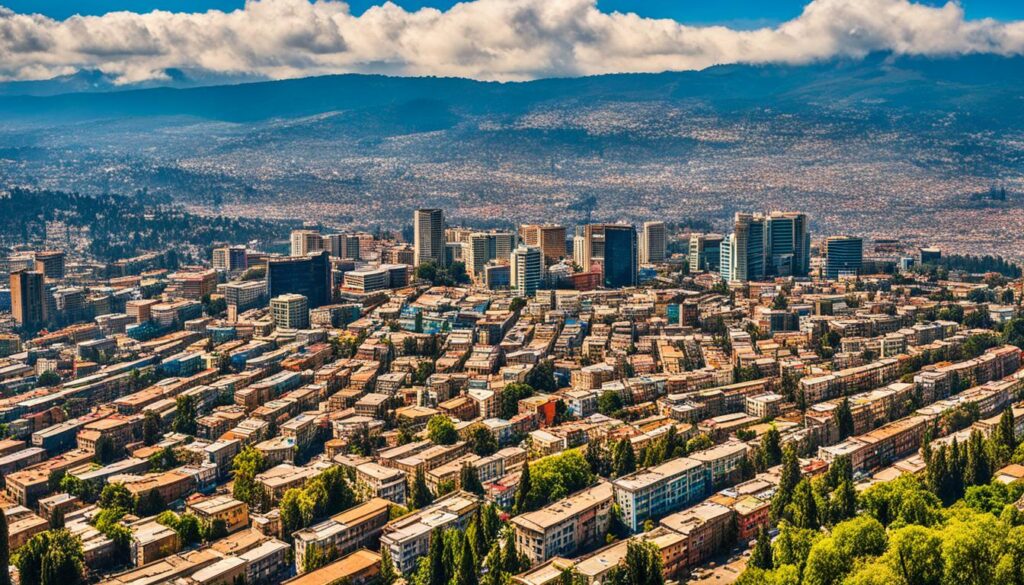How Many People Live in Addis Ababa?
Have you ever wondered how many people call Addis Ababa, the capital city of Ethiopia, their home? Well, you’re about to find out. Addis Ababa is a vibrant city with a rich history and a diverse population. Let’s delve into the numbers and explore the fascinating world of Addis Ababa’s population.
Key Takeaways:
- Addis Ababa has a rapidly growing population, with an estimated 5,704,000 residents in 2024.
- The population of Addis Ababa has been steadily increasing, with an average annual growth rate of 4.45%.
- In 1950, the population of Addis Ababa was only 392,000, indicating significant population growth over the years.
- The population density in Addis Ababa is approximately 5,165 individuals per square kilometer.
- Other cities in Ethiopia, such as Mekele, Dire Dawa, Nazret, and Gondar, also have considerable populations.
Addis Ababa’s Demographics
The population of Addis Ababa is a vibrant tapestry of diverse ethnic groups, languages, and religious beliefs. Amidst this bustling city, the largest ethnic group is the Amhara, making up nearly half of the population. Alongside them, other prominent ethnic groups include the Oromo, Gurage, and Tigray.
Language is another facet of Addis Ababa’s diversity, with Amharic being the primary language spoken by 71% of the city’s residents. Additionally, Oromo is a commonly spoken language with over 10% of the population using it as their means of communication.
Addis Ababa is also a melting pot of religious diversity. Approximately 82% of its population practices Orthodox Christianity, making it the predominant faith in the city. Muslims account for 12.7% of the residents, followed by Protestants and Catholics.
The city’s commitment to education is further reflected in its high literacy rates. Over 93% of males and approximately 80% of females in Addis Ababa are literate, fostering a society that values knowledge and learning.
The History of Addis Ababa
Addis Ababa, the capital city of Ethiopia, has a rich and fascinating historical background. The city was founded by Emperor Menelik II in 1886, who chose the location for its abundant hot springs and favorable climate. Just three years later, in 1889, Addis Ababa became the capital of Ethiopia, marking a significant milestone in its growth and development.
In its early days, Addis Ababa was comprised mainly of circular huts constructed with mud and straw, reflecting the traditional architecture of the region. However, the city underwent a major transformation in the 20th century, experiencing rapid urbanization and modernization. This period of growth propelled Addis Ababa into becoming the political capital of Africa.
Today, Addis Ababa is home to major international organizations, including the African Union and the United Nations Economic Commission for Africa. Its status as a political hub has further cemented its significance and influence in the region.
But Addis Ababa is more than just a political center. It has also emerged as a thriving hub for trade, commerce, and tourism. The city’s vibrant cultural scene, artistic heritage, and unique traditions attract visitors from around the globe. Addis Ababa’s historical and cultural significance make it a destination that offers a blend of past and present experiences.
The Significance of Addis Ababa
Addis Ababa holds great importance not only as the capital city of Ethiopia but also as a center of higher learning, research, and development. The city is home to several universities, research institutions, and international schools, fostering intellectual growth and expanding opportunities.
Addis Ababa’s strategic location within Ethiopia and its growing population have contributed to its economic growth and influence. As the city continues to evolve, it plays a pivotal role in shaping the country’s future and fostering progress.
Overall, Addis Ababa’s historical roots, remarkable growth, and multifaceted significance make it a city of great cultural, political, and economic importance. It continues to be a symbol of Ethiopia’s rich heritage and aspirations for the future.
Addis Ababa’s Urban Development

Addis Ababa’s urban development has been a dynamic process, shaped by various factors over time. Initially, the city grew organically without any preplanned urban planning, resulting in a mix of neighborhoods and an unplanned layout. However, in the early 20th century, urban development initiatives began to take shape as the city underwent significant transformations.
The construction of railways, transportation systems, and modern infrastructure played a crucial role in shaping Addis Ababa’s urban landscape. The introduction of masterplans by French and British consultants in the 1940s further contributed to the city’s development. These masterplans included provisions for the construction of landmarks, civic structures, satellite cities, and improvements to the inner city.
The growth of Addis Ababa has been influenced by various factors, including its topography, the presence of railway systems, and an influx of population. These factors have played a significant role in determining the expansion and development of the city’s infrastructure and services.
One of the most recent masterplans, developed in 2003, aimed to enhance the urban structure and accommodation services further. This plan focused on improving transportation systems, upgrading public spaces, and promoting sustainable development.
The urban development of Addis Ababa continues to evolve as the population grows and new challenges emerge. Efforts are being made to address issues such as traffic congestion, housing shortages, and the need for improved public amenities. By prioritizing sustainable urban planning and strategic development initiatives, Addis Ababa aims to create a city that can meet the needs of its residents while preserving its rich cultural heritage and natural beauty.
Addis Ababa’s Size and Location

Located in the central part of Ethiopia, Addis Ababa covers an area of 527 square kilometers. The city is surrounded by the Special Zone of Oromia, making it a gateway to the diverse regions of the country. Positioned near the East African Rift, Addis Ababa sits between the Nubian Plate and the Somali Plate, showcasing its unique geographical features.
With its strategic positioning, Addis Ababa has become a focal point for commerce, trade, and diplomatic activities. The city’s elevation also sets it apart, as it is situated at 2,355 meters (7,726 feet) above sea level. This high altitude not only provides breathtaking views but also offers a pleasant climate throughout the year.
One of the remarkable geographical features of Addis Ababa is the abundance of eucalyptus trees, a legacy from Emperor Menelik II. These trees not only contribute to the city’s aesthetic appeal but also serve as windbreakers, providing a visual representation of the harmonious coexistence between nature and urban development.
Addis Ababa’s Economic Diversity
Addis Ababa, the capital city of Ethiopia, is not only known for its rich culture and historical landmarks but also for its diverse and thriving economy. The city boasts a wide range of economic industries that contribute to its growth and development.
At the heart of Addis Ababa’s economy is the trade and commerce sector, which plays a vital role in driving the city’s economic activity. The city is a bustling hub of commercial activities, with numerous markets, shopping centers, and business districts that cater to the needs of its residents and visitors alike.
In addition to trade and commerce, manufacturing and production industries also contribute significantly to the city’s economic growth. Addis Ababa is home to various manufacturing facilities that produce goods ranging from textiles and garments to processed food and beverages. These industries provide employment opportunities and stimulate the local economy.
Moreover, homemaking and civil administration are crucial economic sectors in Addis Ababa. The city’s residents engage in activities such as construction, property management, and administrative services, contributing to the overall development and prosperity of the city.
Tourism is another rapidly growing industry in Addis Ababa. The city’s rich cultural heritage, historical sites, and vibrant arts scene attract tourists from around the world. The establishment of more shopping centers, restaurants, and attractions has further enhanced the city’s appeal as a tourist destination. This growth of tourism has not only created job opportunities but also generated revenue for the local economy.
Addis Ababa’s economic diversity, combined with its strategic location and favorable business environment, has led to the city’s remarkable economic growth. As a result, Addis Ababa has earned its place as one of the fastest-growing cities in Africa, with a high human development index.
The availability of jobs, access to clean drinking water, and the development of infrastructure and services have all played a significant role in the city’s economic prosperity. Addis Ababa’s economic industries, including trade and commerce, manufacturing, homemaking, and tourism, have not only contributed to the city’s growth but also improved the standard of living of its residents.
As the city continues to progress, it is expected that Addis Ababa’s economy will further diversify, attracting more investments and creating new opportunities for its residents. This sustained economic growth ensures that Addis Ababa remains a vibrant and thriving city, contributing to the overall development of Ethiopia.
Addis Ababa’s Population Growth and Projections
Addis Ababa, the vibrant capital city of Ethiopia, has experienced consistent population growth over the years. With an annual growth rate of around 3.8% in recent history and reaching as high as 8% in previous years, the city has seen rapid expansion. Currently, Addis Ababa’s population stands at over 5.7 million residents, and it is projected to exceed 6.5 million in the near future.
This steady population growth can be attributed to various factors that make Addis Ababa an attractive destination for individuals and families. The city offers abundant job opportunities, a wide range of amenities, and a thriving urban lifestyle. As a result, more people are choosing to relocate to Addis Ababa, contributing to its growing population.
The future population projections for Addis Ababa indicate a continued increase in residents, ensuring the city’s sustained development and prosperity. This growth is supported by Addis Ababa’s ongoing economic development and its ability to provide a vibrant urban environment that meets the needs of its residents.
Conclusion
Addis Ababa’s population is a testament to the city’s vibrant and thriving nature. With over 5.7 million residents, the city has experienced significant growth and development over the years. Its diverse demographics, historical significance, and economic opportunities continue to attract people from various backgrounds. The population growth of Addis Ababa is not only a reflection of its flourishing economy but also its cultural appeal and status as the capital of Ethiopia.
As Addis Ababa moves into the future, its population is expected to continue growing, further contributing to the city’s ongoing success and prosperity. The city’s ability to provide job opportunities, amenities, and an urban lifestyle remains a pull factor for individuals seeking a better life. The steady population growth also mirrors the city’s efforts in enhancing its infrastructure, services, and overall quality of life.
Addis Ababa’s population summary highlights the city’s trajectory as a thriving and dynamic urban center. Its diverse population, economic opportunities, and historical significance position it as a magnet for both domestic and international migrants. With its continuous growth, Addis Ababa is poised to maintain its status as a vibrant and influential hub in Africa.





